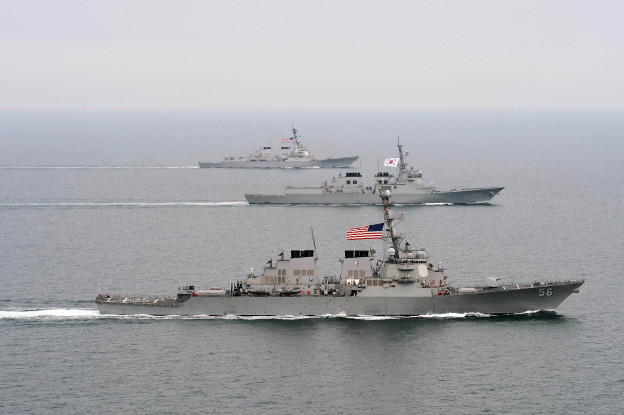
The Navy is confident it has enough space, power and cooling onboard the hull of its planned new line of destroyers to accommodate the planned high-powered Air and Missile Defense Radar (AMDR), Capt. Mark Vandroff, Naval Sea Systems Command program manager for the DDG-51 shipbuilding program, told USNI News in an interview on Thursday.
However, the Arleigh Burke- class destroyer (DDG-51) Flight III would be limited in the amount of additional weapons the ship could accommodate — including electromagnetic railguns and high-energy lasers — without removing other capabilities.
“Depending on how heavy that railgun is, could you fit it on a DDG? My answer is what on that DDG are you willing to live without right now?” Vandroff said.
“You wouldn’t have the space and weight to put on something very large without something relatively sizable coming off.”
As part of a Monday $6.1 billion, nine-ship deal, the service plans to procure three Flight III DDGs beginning in Fiscal Year 2016. The ships will be the first designed for use with the AMDR that will have an emphasis on ballistic missile defense.
The AMDR plans to be a 14 ft. aperture S-band radar (ballistic missile defense and air defense), X-band radar (horizon search) and radar suite controller that will replace the current Lockheed Martin SPY-1D radar found on the current Burke Flight IIAs.
The Navy’s original plan was to procure a new 20,000 ton next-generation cruiser (CG(X)) that would field the AMDR and undertake the BMD mission. The CG(X) program was cancelled in 2010 and the 30 year-old Burkes were restarted to take the BMD role.
In order to accommodate the increased power demands of the AMDR, NAVSEA plans to replace the three existing three-megawatt generators on the ship with the same number of four-megawatt generators to accommodate the extra power.
“That will very comfortably serve this radar and the entire ship running at full battle capability,” Vandroff said.
The Navy’s plan to extend the DDG line into Flight III has come under criticism by Congress and the Government Accountability Office.
The GAO found in 2012, “the inclusion of the AMDR on the existing DDG-51 hull to significant risks in the ship’s design and a reduced future capacity and could result in design and construction delays and cost growth on the lead ship.”
Rep. Randy Forbes (R-Va.) , the chairman of the House Armed Services Subcommittee on Seapower and Projection forces called for the Navy to send a report to Congress on the growth margins for the Flight III ships.
Though the Navy has planned for Flight III for the last three of the ship deal, there is an option for the service to build the ships in the current Flight IIA configuration with the current Aegis weapons system.
“It is on purpose an alterable plan, in that I could execute those ships as Flight IIAs,” Vandroff said.
“I don’t want to be flip, but plans change. In the [budget] environment we’re in now plans might change.”





